Best Beginner Oscilloscopes
Filed under: tools
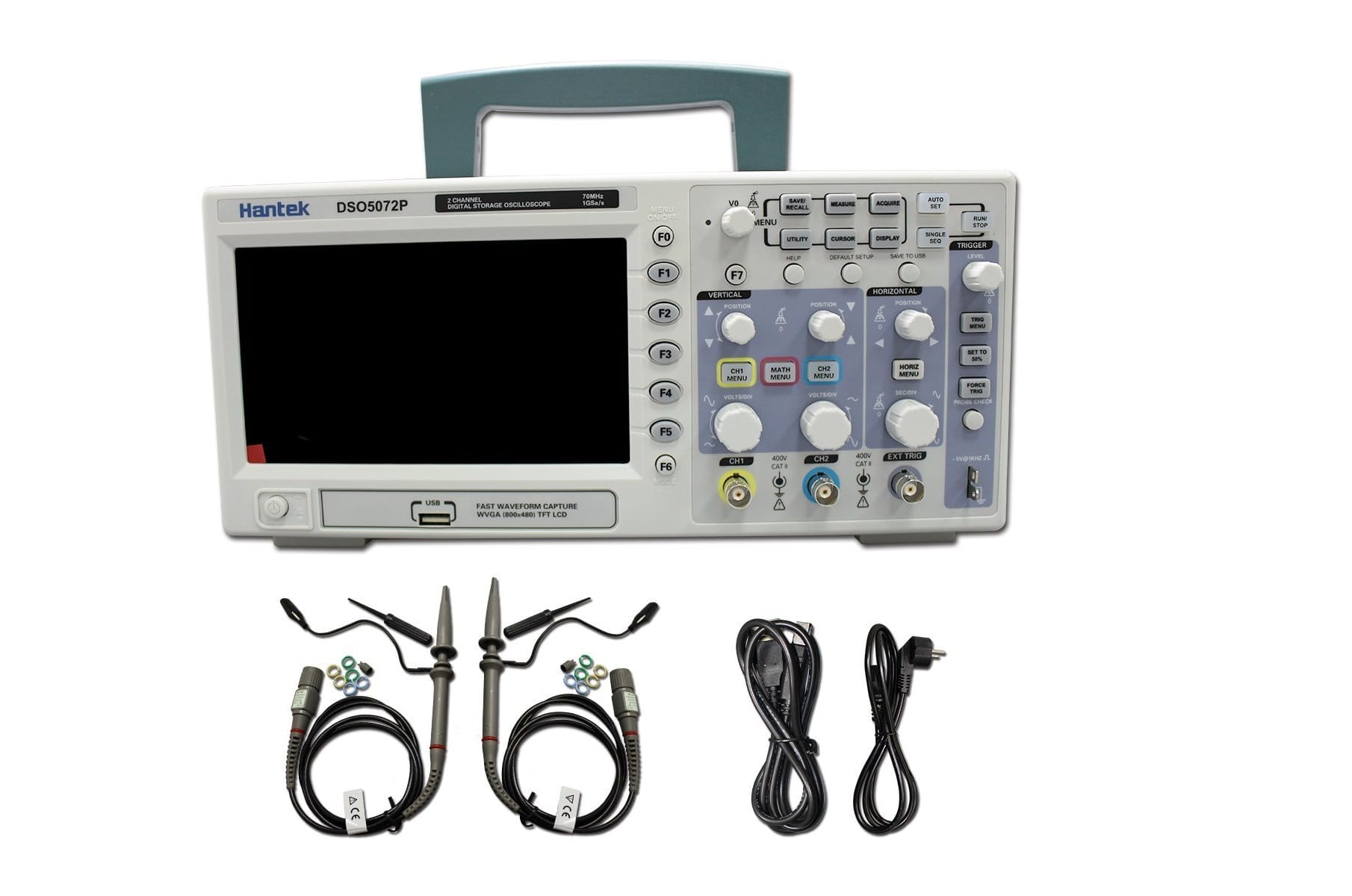
An oscilloscope is a device that is used to display, analyze and record waves from electric signals. The result is a graph that is drawn with respect to time. It basically measures electronic waves. If you want to find the best beginner oscilloscopes in the market, you first need to know the best features to look for in one of these devices. Before you find out about the best features, you also need to consider what you will be using the device for.
Uses of Oscilloscopes
There are a few questions that you want to ask yourself before you invest in one of these devices. These include:
- The location: Where will you use this device? Is it at a customer’s site, a laboratory or even under the hood of a car?
- Amplitude: What are the maximum and minimum amplitudes of the signals that you intend to measure?
- Time factor: Are you measuring single shot or repetitive signals?
- Quantity: Are you only measuring one signal or do you need to measure multiple signals at once?
- Frequency: How high is the frequency of the signal that you intend to measure?
- Viewing: Would you like spectrum analysis, that is, viewing the signals in the frequency domain only or would you also like to have a time domain?
With these questions, you would be able to find exactly what you are looking for in an oscilloscope. This is because you will easily be able to match your need with the scope of the solution that the device provides.
Tips for Buying Oscilloscopes
If you would like to get the best oscilloscope in the market, there are a number of factors that you need to consider. These include:
- Analog versus Digital
There is still a debate in people’s minds about whether to get an analog or a digital oscilloscope. The answer is pretty simple. Do not buy an analog oscilloscope unless you want it as a collector’s item. These devices have functions that are several notches lower than their digital counterparts. Some might be cheaper but they will provide limited functions. Digital Storage Oscilloscopes have a number of advantages over their analog counterparts. They:
- Have high bandwidths
- Have color displays
- Possess single shot ability
- Are small and therefore easily portable
- Provide measurements on the screen
- Have straightforward and simple user interface
- Can print and provide storage as well
Additionally, getting a cheap analog oscilloscope seems cheap only while you are buying it. The spare parts and repair cost a lot since these devices are o longer in production. What might seem economical in the beginning might end up being more expensive in the end.
- Bandwidth
Bandwidth deals with the frequency of the signal. It is the maximum frequency that can go through the front-end amplifiers. Once you have established the maximum frequency of the signal that you intend to measure, you can now choose bandwidth which is supposed to be five times higher than that of the signal’s maximum frequency. This is necessary as it allows for accurate representation of the wave form. However, it is important to note that scopes with higher bandwidth are usually more expensive.
- Sample Rate
Most oscilloscopes manufacturers only list the highest sampling rate to appeal to the buyers. However, you would need to check that the specification applies to all signals for it to be useful to you. For oscilloscopes, there are two types of sampling rates: the real-time sampling rate commonly referred to as RTS and the equivalent time sampling rate commonly referred to as ETS. These rates are measured in Mega- or Giga- samples per second. The ETS is often higher.
If you are measuring single shot signals, then you would use the RTS. The ETS works for stable and repetitive signals which necessitate building of the waveform. When you are buying an oscilloscope, you want to get a sampling rate that is at least five times the maximum frequency of the wave that you are going to measure. This helps in accurate reconstruction of the wave form. However, the Nyquist criterion states that you would need at least twice the maximum frequency of the signal that you intend to measure.
- Memory Depth
Memory depth is one of the least understood aspects of digital oscilloscopes. It is related to sampling rate and determines how long the signal can be captured before the memory is full. The memory depth is actually equivalent to the sampling rate by the time across the display. You therefore need an oscilloscope that has significant memory depth. This way, you are able to capture the waveform in a satisfactory manner.
- Number of Channels
The number of channels determines the number of signals that you are able to view. This is why you need to know what you want the oscilloscope for before buying it. Two and four channel scopes do not cut it anymore. You would need a mixed signal oscilloscope, referred to as the MSO, if you would like to view all the signals that you are interested in. These scopes offer two to four analog channels and up to sixteen digital channels.
- Resolution and Accuracy
An oscilloscope needs high resolution if you are going to detect the small percentage signal changes in signals. For digital signals, you can comfortably work with an 8-bit resolution. However, when it comes to analog signals such as audio, vibration, noise and monitor sensors such as temperature and pressure, you need higher resolutions which will offer higher accuracy. These would be 12 or even 16-bit resolution scopes.
- Handheld or PC Oscilloscopes
Handheld oscilloscopes are great for rugged and outdoor environments where your PC would get damages. However, they are limited when it comes to battery capacity and display. Their displays are small and can therefore be hard to read. Finding an oscilloscope that can connect to your PC is therefore better value for your money.
- Probes
This is not a feature of the oscilloscope itself. However, it is still as important. Some manufacturers downplay the importance of probes. You should ensure that your probes at least match the bandwidth of your device.
With these tips, you can be able to find the best beginner oscilloscopes in the market. These guidelines help you to have an idea of what you need to look for in any scope that you consider buying. These features are important and will determine how well the scope gets the job done.
Best Oscilloscopes for Beginners – Reviews
Now that you are in search of a good beginner oscilloscope, these reviews will come in handy. These are the best and most affordable devices in the market for beginners. They include:
Rigol DS1102E Digital Oscilloscope
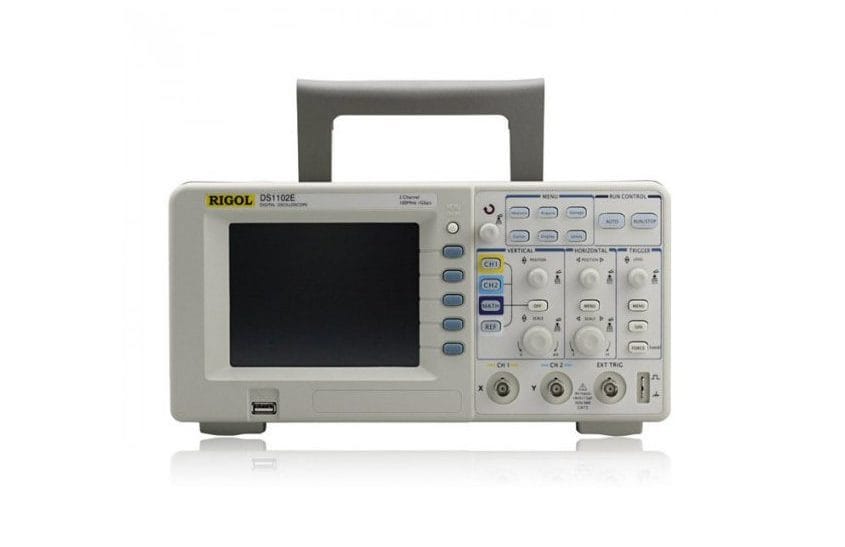
The Rigol DS1102E provides the user with dual channels and one external trigger channel. It provides three types of cursor measuring options including manual, track and auto. The 20 type wave parameter has 10 voltage and 10 time parameters. This digital oscilloscope also has application software for PC, UltraScope, which is powerful. It performs remote and local operations, captures the waves and measures them and also saves the waves in .txt, .xls files and .bmp formats.
The 100MHz bandwidth digital oscilloscope has a maximum real-time sample rate of 1GSa/s for each channel and an equivalent time sample rate of 25GSa/s. It also has a memory depth of 1Mpts long. The Rigol oscilloscope has a sturdy construction and the buttons feel great. In addition to this, the device has a simple menu which is easy to use and understand. The screen is clear and comes in color plus the device has some good trigger options. These features make it one of the best beginner oscilloscopes in the market.
Rigol DS1052E Digital Oscilloscope
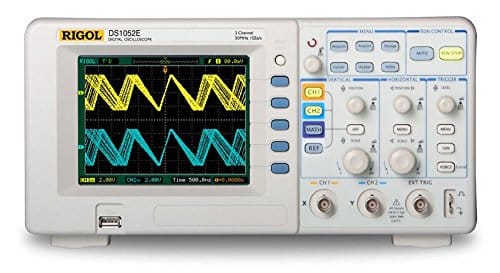
The Rigol DS1052E oscilloscope is a digital device that features two analog channels. The interface has multiple configurations. It also features five trigger controls, that is: pulse width, video, edge, alternate trigger and slope. It has 100MHz bandwidth, a maximum real-time sample rate of 1GSa/s and an equivalent time sample rate of 25GSa/s. the digital oscilloscope also features a memory depth of 1Mpts long and low noise high performance.
This oscilloscope has a built-in help system, file management, a keyboard lock and waveform record. It is one of the best beginner oscilloscopes. It is easy to use and the auto button will make it much easier because it does everything for you. Another great feature of the oscilloscope is that it can be controlled using a PC and the software is included.
Hantek DSO5072P Digital Oscilloscope

The Hantek DSO5072P has a 70MHz bandwidth and maximum real-time sample rate of 1GSa/s. it also has a 25GSa/s equivalent time sample rate. It features two channels and has six trigger control options including: edge, pulse, video, slope, over time and alternative trigger source. The oscilloscope can record length of up to 40K and has a 7-inch color display screen. It also has an XY mode but does not have a frequency counter built-in.
This Hantek digital oscilloscope is one of the best for beginners because of how simple it is to use. The user guide is sufficient and the pop-up menu helps to navigate the functions easily. You can use the device on a small work bench because of its relatively small form. Additionally, the quality of the screen is impressive and the fan noise is low. These are great features even for a beginner oscilloscope.
Siglent Technologies SDS1052DL+
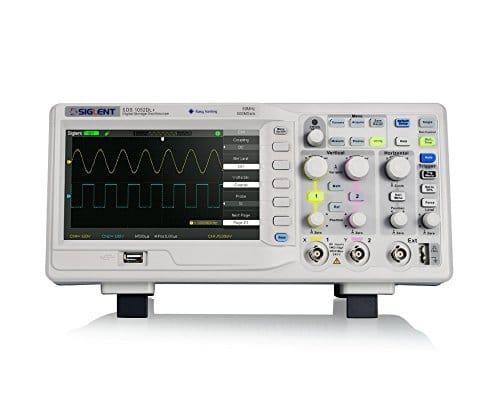
This is a newer version of the SDS1052DL. It features a better LAN interface and has a better LCD display with higher resolution. The digital oscilloscope has two channels, a USB interface and a 500MS/s maximum real-time sample rate. It also has a 32Kpts long memory depth and 50MHz bandwidth. The device also features math, cursors and a built-in frequency counter.
The Siglent Technologies SDS1052DL+ is surprisingly accurate and easy to use. The TFT screen display is great and the on screen menu allows you to set up the device easily. It is one of the best beginner oscilloscopes because of all the functions it offers. You can therefore use it as a general purpose oscilloscope.
Siglent Technologies SDS1202X-E
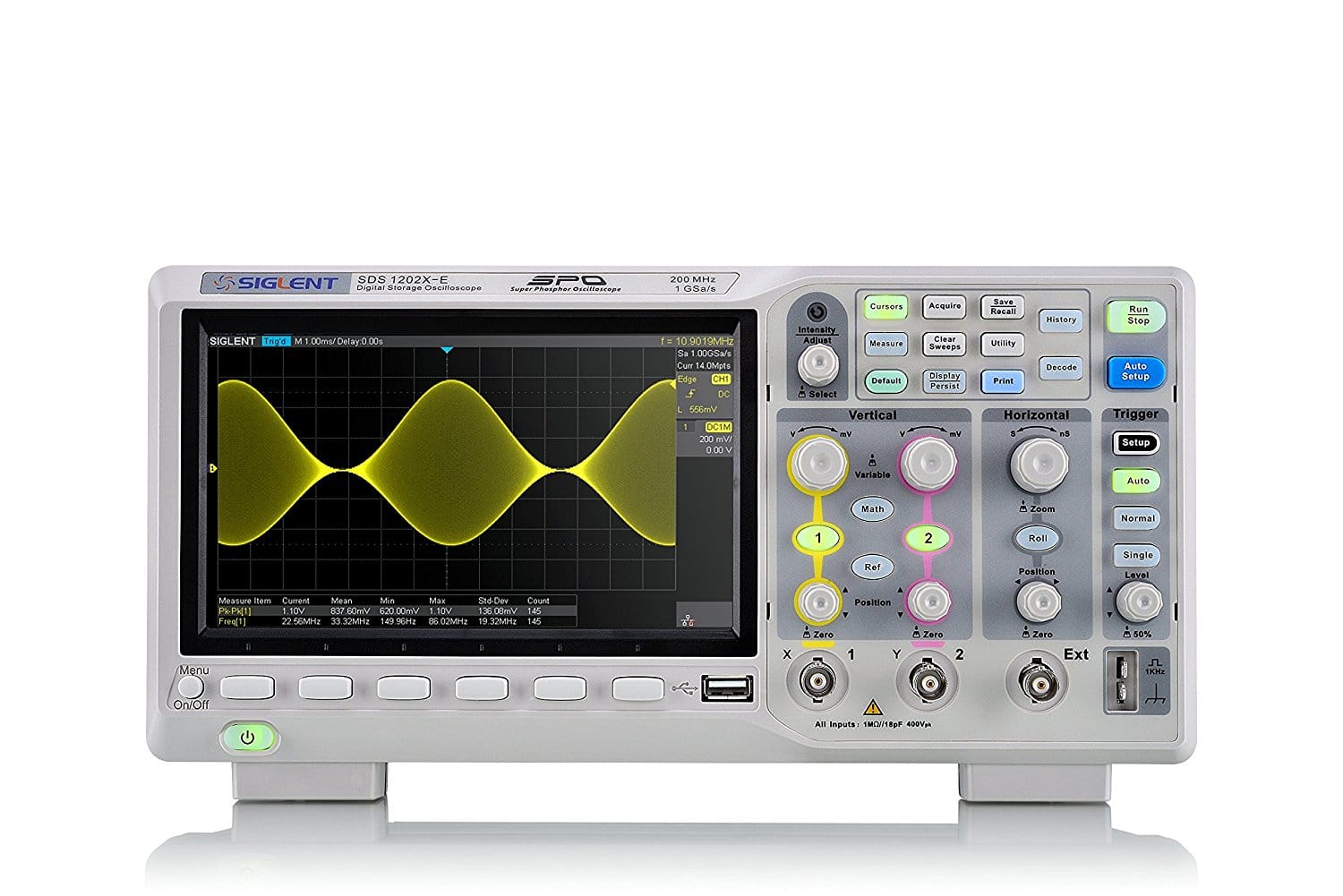
The Siglent Technologies SDS1202X-E is a digital oscilloscope that features 200MHz bandwidth and a maximum real-time sample rate of 1GSa/s. It has 14Mpts long memory depth and standard serial bus triggering. The device also has a 256-intensity grading and color temperature display. The SPO technology provides refresh rates that are fast. To add onto this, the Siglent Technologies digital oscilloscope has a 1M points FFT math function.
This digital oscilloscope has an intuitive user interface and knobs and buttons that feel good. This is one of the best beginner oscilloscopes because it offers a range of impressive functions that are often found in more expensive devices.
Hantek DSO5202P Digital Oscilloscope
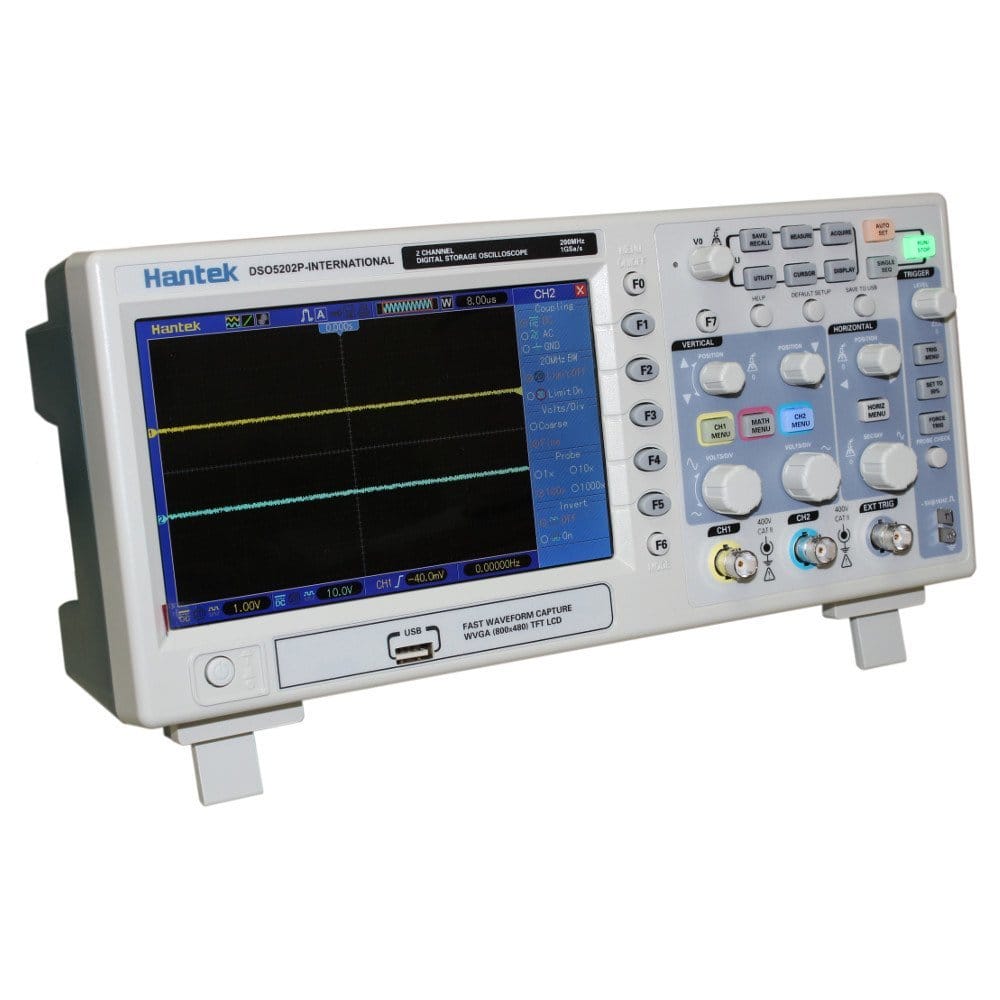
The Hantek DSO5202P digital oscilloscope features 200MHz bandwidth and a maximum real-time sample rate of 1GSa/s. It has a 7-inch display and records lengths of up to 40K. It has various trigger modes including but not limited to overtime, edge, line selectable video and pulse width. This device has four math functions and multiple automatic measurements. It also has two channels and comes with PC software to enable real-time analysis specifications.
This device is lightweight and works as a middle range digital oscilloscope. It is easy to use and has user-friendly menus. The scope provides unlimited capabilities and the scope is pretty stable past its rated sweep. In addition to this, it is easy to set up and has some great math functions including FFT.
Summary
If you would like to get one of the best beginner oscilloscopes, then you can choose between these options. They are great scopes for beginners and provide quite some value for the price. Apart from affordability, some of these oscilloscopes also have advanced functions that are only present in more expensive and advanced scopes.